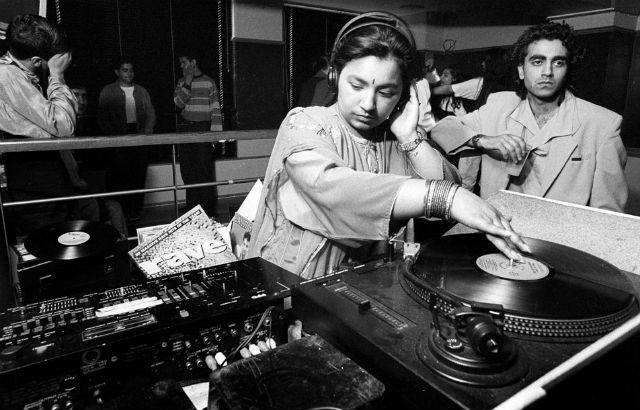Interactive timeline captures impact of Indian community in Britain
A photographic timeline that showcases the history of Indians living in Britain over the past two centuries is now available to view online.

DJ Radical Sister playing at a Bradford nightclub in 1988. Credit: Tim Smith
‘India in Britain’ is the culmination of a 10-year research project led by Professor Susheila Nasta, who joined Queen Mary University of London in September from the Open University, where she remains Emeritus Professor.
Designed to celebrate the “fascinating yet forgotten stories” of how the historic Indian presence has critically shaped Britain, the project explored South Asian and Indian-British connections from the period of the British Raj to the present day.
“Challenging stereotypes”
According to the curators, the photographs “challenge stereotypes of Britain’s ‘island story’ by revealing the contributions of those who settled in Britain from India, either directly, or via East Africa or the Caribbean.”
The timeline was launched by the Indian High Commissioner to the UK on India’s 69th Republic Day, and features photographs curated for the UK-India Year of Culture 2017.
Through historic and contemporary images, the collection showcases India’s impact on Britain’s cultural, intellectual and political life, national and global politics, human rights and equality, the arts and sport.
It highlights the many individuals who have helped to shape British life – from teachers, policemen and bus drivers to the activist Mahatma Gandi and musician Ravi Shankar. There are images of Amar Singh, the first London Underground worker to wear a turban, and Cornelia Sorabji, the first woman to study Law at the University of Oxford.
Intertwined histories
The timeline also documents moments of adversity, featuring images of Indian suffragettes and marches against discrimination, as well as the poor housing conditions that many Indians faced.
Commenting on the timeline, Professor Nasta said: “The images trace Indian-British interactions across the divides of race, class, and gender, drawing public attention to the complex realities of both countries’ intertwined histories. We hope this will fire imaginations and provoke reflection so we remember the huge impact India and South Asia have had on contemporary British life.”
The project was a collaboration between the Open University, the University of Exeter, the High Commission of India, the Nehru Centre in London and India’s Ministry of External Affairs. The exhibition was conceived and curated by Professor Nasta in collaboration with Dr Florian Stadtler from the University of Exeter and Dr Maya Parmar from the Open University and the University of Exeter.
Key photographs from the timeline went on public display during an outdoor touring exhibition, launched in Edinburgh, London and Leeds at the end of 2017.
Professor Nasta is Editor-In-Chief at Wasafiri Magazine, which she originally founded at Queen Mary in 1984. Her research seeks to promote cultural diversity in Britain and highlight its long migrant history. She is currently co-editing the first Cambridge History of Black and Asian British Writing.
More information
• View the timeline
• More information about Wasafiri
• Find out more about studying English at Queen Mary University of London
Related items

20 May 2025

19 May 2025
For media information, contact: